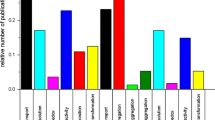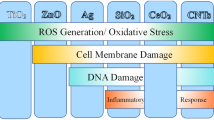Abstract
Nano-sized palladium (nano-Pd) is used in catalytic converters of automobiles, where it can be released into the environment by abrasion. Although these particles may subsequently be transported into surface water bodies, no data estimating their fate and toxicity in aquatic systems exists. This study characterized the particle size development of nano-Pd (advertised size ~12 nm; hydrodynamic size ~70 nm) in media with variable ionic strength (IS). Additionally, the particles’ acute toxicity for daphnids and chironomids was assessed. While nano-Pd agglomerated more quickly with increasing IS, it caused only marginal effects in both test species after 96 h of exposure. After 144 h of exposure, however, an EC50 value of 1.23 mg nano-Pd/L for daphnids was determined indicating effects over the long run. When considering the relatively low environmental concentration of elemental Pd in surface waters (usually ng/L), though, this study suggests only a low aquatic risk in response to nano-Pd.


Similar content being viewed by others
References
ASTM E729-96 (2007) Standard guide for conducting acute toxicity tests on test materials with fishes, macroinvertebrates and amphibians. ASTM International, West Conshohocken
Baun A, Hartmann NB, Grieger K, Kusk KO (2008) Ecotoxicity of engineered nanoparticles to aquatic invertebrates: a brief review and recommendations for future toxicity testing. Ecotoxicology 17:387–395
Bednarova I, Mikulaskova H, Havelkova B, Strakova L, Beklova M, Sochor J et al (2014) Study of the influence of platinum, palladium and rhodium on duckweed (Lemna minor). Neuro Endocrinol Lett 2:35–42
Bundschuh M, Zubrod JP, Englert D, Seitz F, Rosenfeldt RR, Schulz R (2011) Effects of nano-TiO2 in combination with ambient UV-irradiation on a leaf shredding amphipod. Chemosphere 85:1563–1567
Chen M, Chen S, Du M, Tang S, Chen M, Wang W (2015) Toxic effect of palladium on embryonic development of zebrafish. Aquat Toxicol 159:208–216
Chikuma M, Aoki H, Tanaka H (1991) Determination of metal ions in environmental waters by flameless atomic absorption spectrometry combined with preconcentration using a sulfonated dithizone-loaded resin. Anal Sci 7:1131–1134
Core Team R. 2.15.3 (2013). R foundation for statistical computing, Vienna, Austria
Cross RK, Tyler C, Galloway TS (2015) Transformations that affect fate, form and bioavailability of inorganic nanoparticles in aquatic sediments. Environ Chem 12:627–642
Dabrunz A, Duester L, Prasse C, Seitz F, Rosenfeldt R, Schilde C, Schaumann GE, Schulz R (2011) Biological surface coating and molting inhibition as mechanisms of TiO2 nanoparticle toxicity in Daphnia magna. PLoS One 6:e20112
Domingos RF, Tufenkji N, Wilkinson KJ (2009) Aggregation of titanium dioxide nanoparticles: role of a fulvic acid. Environ Sci Technol 43:1282–1286
Göbel P, Dierkes C, Coldewey WG (2007) Storm water runoff concentration matrix for urban areas. J Contam Hydrol 91:26–42
Heugens EHW, Hendriks AJ, Dekker T, Straalen NMv, Admiraal W (2001) A review of the effects of multiple stressors on aquatic organisms and analysis of uncertainty factors for use in risk assessment. Crit Rev Toxicol 31:247–284
Hodge VF, Stallard MO (1986) Platinum and palladium in roadside dust. Environ Sci Technol 20:1058–1060
Jarvis KE, Parry SJ, Piper JM (2001) Temporal and spatial studies of autocatalyst-derived platinum, rhodium, and palladium and selected vehicle-derived trace elements in the environment. Environ Sci Technol 35:1031–1036
Klüttgen B, Kuntz N, Ratte HT (1996) Combined effects of 3,4-dichloroaniline and food concentration on life-table data of two related cladocerans, Daphnia magna and Ceriodaphnia quadrangula. Chemosphere 32:2015–2028
Noss C, Dabrunz A, Rosenfeldt RR, Lorke A, Schulz R (2013) Three-dimensional analysis of the swimming behavior of Daphnia magna exposed to nano-sized titanium dioxide. PLoS One 8:e80960
Oberdörster E, Zhu S, Blickley TM, McClellan-Green P, Haasch ML (2006) Ecotoxicology of carbon-based engineered nanoparticles: effects of fullerene (C60) on aquatic organisms. Carbon 44:1112–1120
OECD (2004) Test no. 202: Daphnia sp. acute immobilisation test, OECD guidelines for the testing of chemicals, Section 2. OECD Publishing, Paris
OECD (2008) Test no. 211: Daphnia magna reproduction test, OECD guidelines for the testing of chemicals, Section 2. OECD Publishing, Paris
OECD (2011) Test no. 235 Chironomus sp. acute immobilisation test, OECD guidelines for the testing of chemicals, Section 2. OECD Publishing, Paris
Ravindra K, Bencs L, Van Grieken R (2004) Platinum group elements in the environment and their health risk. Sci Total Environ 318:1–43
Rose RM, Warne MSJ, Lim RP (2002) Food concentration affects the life history response of Ceriodaphnia cf. dubia to chemicals with different mechanisms of action. Ecotoxicol Environ Saf 51:106–114
Rosenkranz P, Chaudhry Q, Stone V, Fernandes TF (2009) A comparison of nanoparticle and fine particle uptake by Daphnia magna. Environ Toxicol Chem 28:2142–2149
Seitz F, Lüderwald S, Rosenfeldt RR, Schulz R, Bundschuh M (2015a) Aging of TiO2 nanoparticles transiently increases their toxicity to the pelagic microcrustacean Daphnia magna. PLoS ONE 10:e0126021
Seitz F, Rosenfeldt RR, Storm K, Metreveli G, Schaumann GE, Schulz R (2015b) Effects of silver nanoparticle properties, media pH and dissolved organic matter on toxicity to Daphnia magna. Ecotoxicol Environ Saf 111:263–270
Shah NK, Wai CM (1985) Extraction of palladium from natural samples with bismuth diethyldithiocarbamate for neutron activation analysis. J Radioanal Nucl Chem 94:129–137
Sillanpää M, Tiina-Mari P, Pirjo S (2011) Aggregation and deposition of engineered TiO2 nanoparticles in natural fresh and brackish waters. J Phys Conf Ser 304:012018
Somorjai GA, Li Y (2010) Selective nanocatalysis of organic transformation by metals: concepts, model systems, and instruments. Top Catal 53:832–847
Suttiponparnit K, Jiang J, Sahu M, Suvachittanont S, Charinpanitkul T, Biswas P (2010) Role of surface area, primary particle size, and crystal phase on titanium dioxide nanoparticle dispersion properties. Nanoscale Res Lett 6:1–8
Wang Y, Li X (2012) Health risk of platinum group elements from automobile catalysts. Procedia Eng 45:1004–1009
WHO (2002) Environmental health criteria 226: palladium. World Health Organization, Geneva
Wilkinson KE, Palmberg L, Witasp E, Kupczyk M, Feliu N, Gerde P, Seisenbaeva GA, Fadeel B, Dahlen S-E, Kessler VG (2011) Solution-engineered palladium nanoparticles: model for health effect studies of automotive particulate pollution. ACS Nano 5:5312–5324
Xiong D, Fang T, Yu L, Sima X, Zhu W (2011) Effects of nano-scale TiO2, ZnO and their bulk counterparts on zebrafish: acute toxicity, oxidative stress and oxidative damage. Sci Total Environ 409:1444–1452
Zereini F, Alt F, Messerschmidt J, Wiseman C, Feldmann I, von Bohlen A (2005) Concentration and distribution of heavy metals in urban airborne particulate matter in Frankfurt am Main, Germany. Environ Sci Technol 39:2983–2989
Zereini F, Wiseman C, Püttmann W (2007) Changes in palladium, platinum, and rhodium concentrations, and their spatial distribution in soils along a major highway in Germany from 1994 to 2004. Environ Sci Technol 41:451–456
Acknowledgments
We acknowledge the helpful comments by reviewers and editors on earlier versions of this manuscript. The present study is part of the research group INTERNANO, supported by the German Research Foundation (SCHU2271/5-2) and additionally by funding from the Ministry of Science Rhineland-Palatinate.
Author information
Authors and Affiliations
Corresponding author
Rights and permissions
About this article
Cite this article
Lüderwald, S., Seitz, F., Seisenbaeva, G.A. et al. Palladium Nanoparticles: Is There a Risk for Aquatic Ecosystems?. Bull Environ Contam Toxicol 97, 153–158 (2016). https://doi.org/10.1007/s00128-016-1803-x
Received:
Accepted:
Published:
Issue Date:
DOI: https://doi.org/10.1007/s00128-016-1803-x




